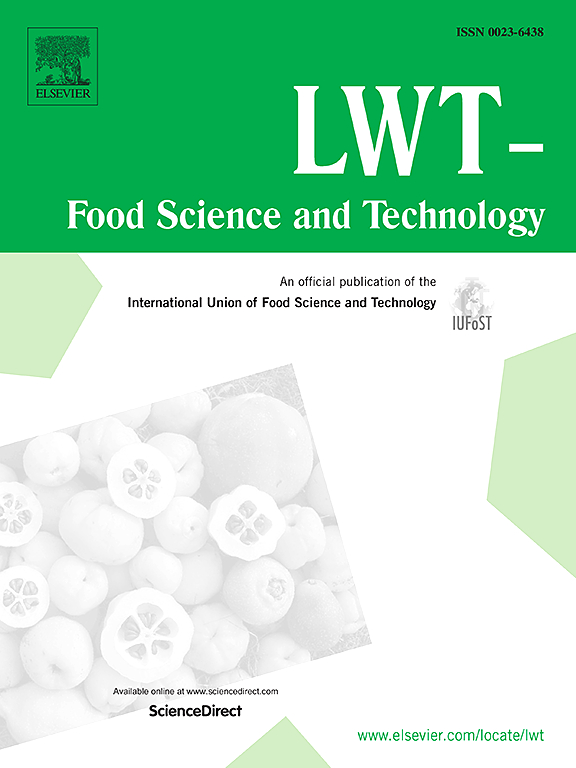Development and optimisation of sodium alginate and chitosan edible films with sea fennel by-product extract for active food packaging
IF 6
1区 农林科学
Q1 FOOD SCIENCE & TECHNOLOGY
引用次数: 0
Abstract
Sea fennel by-product (woody stems and flowers), rich in phenolic compounds, possesses strong antioxidants and antimicrobial properties, making it a promising ingredient for sustainable food packaging. Utilizing plant-based by-products in biopolymer films can enhance their functional properties while promoting waste valorisation and environmental sustainability. This study aimed to develop and optimise sodium alginate-chitosan edible films incorporated with sea fennel by-product extract (SFBPE) for improved antioxidant activity, barrier properties, and food preservation applications. The films were optimised using central composite design response surface methodology (CCD-RSM), characterised, and applied as an edible coating for fresh strawberries. The optimal formulation contained 6.0 mL/100 mL SFBPE, 1.5 g/100 mL sodium alginate, 1.1 g/100 mL chitosan, and 1.5 mL/100 mL glycerol, yielding a film with a thickness of 0.085 mm, tensile strength of 5.77 MPa, and water contact angle of 77.9°. Incorporating SFBPE enhanced total phenolic content, antioxidant activity, hydrophobicity, and opacity of the optimised film compared to the control (without SFBPE), with only a minor reduction in mechanical properties. The lightness of the films decreased by 21.92 % with SFBPE addition. Spectroscopic analysis confirmed strong interactions between the polymeric matrix and the SFBPE. The SFBPE-containing coating effectively preserved the freshness of strawberries for up to 13 days in cold storage, demonstrating its potential as a sustainable food packaging solution.
含海茴香副产物提取物的海藻酸钠壳聚糖食用膜的研制与优化
海茴香的副产品(木质茎和花)富含酚类化合物,具有很强的抗氧化剂和抗菌性能,使其成为可持续食品包装的有前途的成分。在生物聚合物薄膜中利用植物副产品可以增强其功能特性,同时促进废物增值和环境可持续性。本研究旨在开发和优化海藻酸钠-壳聚糖可食用薄膜,并添加海茴香副产物提取物(SFBPE),以提高其抗氧化活性、屏障性能和食品保鲜应用。利用中心复合设计响应面法(CCD-RSM)对薄膜进行优化,对其进行表征,并将其应用于新鲜草莓的可食用涂层。最佳配方为:SFBPE 6.0 mL/100 mL、海藻酸钠1.5 g/100 mL、壳聚糖1.1 g/100 mL、甘油1.5 mL/100 mL,膜厚0.085 mm,抗拉强度5.77 MPa,水接触角77.9°。与对照组(不含SFBPE)相比,加入SFBPE提高了优化膜的总酚含量、抗氧化活性、疏水性和不透明度,机械性能仅略有下降。加入SFBPE后,薄膜的亮度降低了21.92%。光谱分析证实了聚合物基质与SFBPE之间的强相互作用。含有sfbpe的涂层在冷藏中有效地保持了草莓的新鲜度长达13天,显示了其作为可持续食品包装解决方案的潜力。
本文章由计算机程序翻译,如有差异,请以英文原文为准。
求助全文
约1分钟内获得全文
求助全文
来源期刊

LWT - Food Science and Technology
工程技术-食品科技
CiteScore
11.80
自引率
6.70%
发文量
1724
审稿时长
65 days
期刊介绍:
LWT - Food Science and Technology is an international journal that publishes innovative papers in the fields of food chemistry, biochemistry, microbiology, technology and nutrition. The work described should be innovative either in the approach or in the methods used. The significance of the results either for the science community or for the food industry must also be specified. Contributions written in English are welcomed in the form of review articles, short reviews, research papers, and research notes. Papers featuring animal trials and cell cultures are outside the scope of the journal and will not be considered for publication.
 求助内容:
求助内容: 应助结果提醒方式:
应助结果提醒方式:


